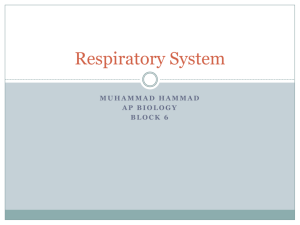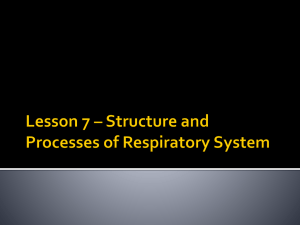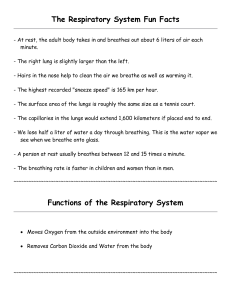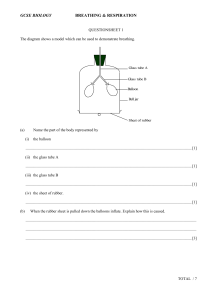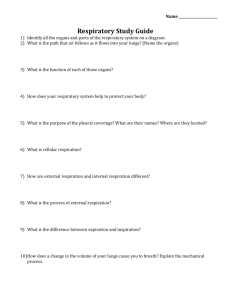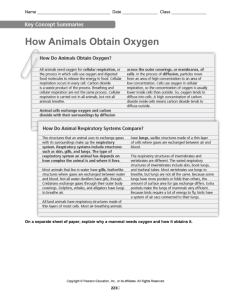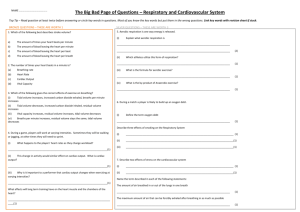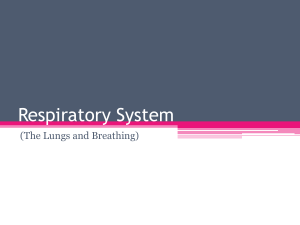Lesson 6 Intro Respiratory System
advertisement
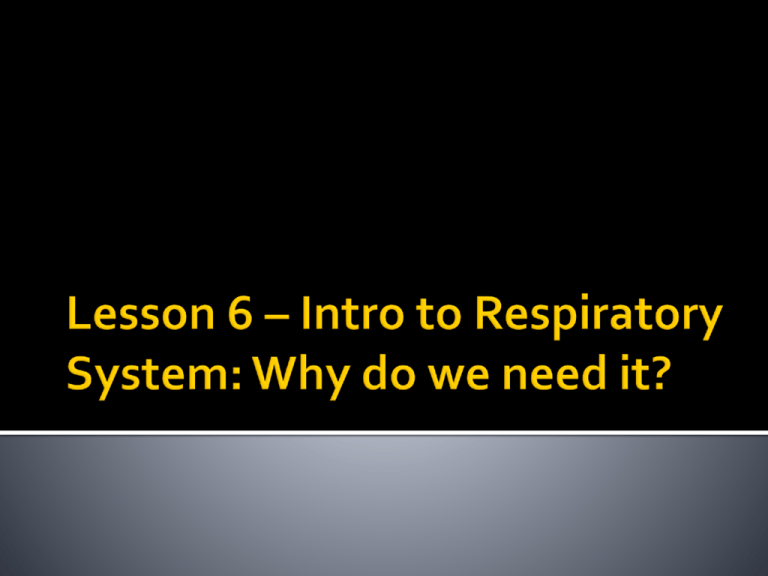
We take about 12-15 breaths per minute How many breaths per day? How many breaths per lifetime? You take between 500 million to 750 million breaths per lifetime We breath in a mixture of gases: 78% Nitrogen 21% Oxygen 1% Argon 0.04% Carbon Dioxide Other trace amounts of gases But it’s the OXYGEN that our cells need! Think about why cells need oxygen and discuss with you peers Cells use oxygen to obtain energy from food through a process called aerobic cellular respiration. Energy is released in a cell when glucose (sugar molecule) reacts with oxygen to form carbon dioxide and water. Aerobic Cellular Respiration: series of chemical reactions that occur in the cell that provide energy and consume oxygen. C6H12O6 + 6O2 glucose + oxygen 6CO2 + 6H2O + energy carbon dioxide +water + energy 64% is released as thermal energy or energy that helps animals maintain a constant body temperature. 34% of the energy is stored in molecules called ATP (adenosine triphosphate). Cells use ATP to power almost all of their energy requiring processes: Growth Movement Building new molecules 1 glucose yields, 36 molecules of ATP ATP is formed when energy from the breakdown of glucose is used to add a phosphate group to the ADP (adenosine diphosphate) molecule in a process called phosphorylation. In ‘simple’ organisms like jellyfish and sponges, oxygen from the environment diffuses directly into the cells through the cell membrane and carbon dioxide diffuses out into the environment Gas Exchange: the processes whereby the body cells obtain oxygen and get rid of carbon dioxide. (aka: diffusion of gases) Ventilation: the process in more complex organisms that ensures a flow of oxygen-rich air to the lungs. (aka: breathing) In humans, fish and other large multi-cellular organisms, gas exchange occurs in two locations Lungs Body cells The human respiratory system has four important structural features that enable it to function properly: A thin permeable respiratory membrane through which diffusion can occur A large surface area for gas exchange A good supply of blood A breathing system for bringing oxygen-rich air to the respiratory membrane The oil in the machine of our body We make about 1 – 1.5 litres per day When sick, consistency changes (or from dehydration) Allergies (and some infections) cause leakage of mucus producing cells Green colour can be from Neutrophils High Surface area Air is 37oC and moist Membrane is one cell thick Passive Transport. Breathing is based on negative pressure Breathing is based on negative pressure TOTAL LUNG CAPCITY: TIDAL VOLUME: The maximum volume of air that can be inhaled The volume of air inhaled or exhaled during a during a single breath. normal, involuntary breath. It's about 0.5L in the average adult or 10% of the total lung capacity. INSPIRATORY RESERVE VOLUME: EXPIRATORY RESERVE VOLUME: The amount of additional air that can be The volume of additional air that can be inhaled after a normal inhalation. exhaled after a normal exhalation. RESIDUAL VOLUME: The volume of air that remains in the lungs after a forced exhalation. The residual volume of air prevents the lungs from collapsing. VITAL CAPACITY: The maximum amount of air that can be inhaled or exhaled. During periods of high demand for oxygen the reserve volumes decrease and tidal volume increases. The maximum tidal volume is the vital capacity. Vital capacity is about 4.4L to 4.8L in males and 3.4L to 3.8L in females. Physical activity depends on the energy released during aerobic cellular respiration which depends on the rate of oxygen delivary a high maximum rate of oxygen usage indicates an efficient respiratory system. The rate of oxygen usage can be calculated using a spirometer. VO2: It is an estimated or measured value representing the rate at which oxygen is used in the body. It is measured in millilitres per kilogram per minute (mL/kg/min) VO2max: The maximum rate at which oxygen can be used in an individual. It is the maximum amount of oxygen that an individual can use during sustained, intense physical activity. It is also measured in mL/kg/min. EPO -- a hormone naturally produced by human kidneys to stimulate red blood cell production
